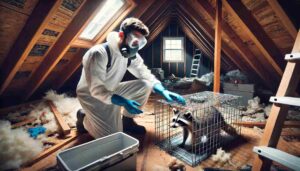Ever found yourself pondering the peculiar possibility of cats and raccoons getting romantically involved? Well, you’re not alone. I, too, once stumbled upon a fascinating encounter between these two furry creatures and couldn’t help but wonder if there was more to it than meets the eye. Can cats and raccoons mate?
While cats and raccoons are physically capable of mating, cannot produce offspring together due to significant genetic and physiological differences. The distinction between these two species lies in their evolutionary lineage and reproductive mechanisms. Cats belong to the Felidae family, while raccoons belong to the Procyonidae family. These familial differences result in a substantial genetic barrier, preventing successful interbreeding.
Moreover, the mating behaviors of cats and raccoons are markedly distinct. Male cats are known for their territorial marking using urine and pheromones to attract females. Mating behavior in cats often appears aggressive, with males pouncing, biting, and growling during the courtship process.
On the other hand, female raccoons are monogamous, mating with only one male during the breeding season. Juvenile female raccoons may begin breeding during their first year, but this behavior is entirely within their species.
But that’s not all. In this article, I’ll explore the science, stories, and myths surrounding this unlikely connection. Keep reading!
Understanding the Species
Before delving into the intriguing question of whether cats and raccoons can mate, it’s essential to establish a foundational understanding of these two distinct species. Cats (Felis catus) and raccoons (Procyon lotor) are fascinating creatures, each with its unique characteristics, behaviors, and evolutionary adaptations.
Overview of Cats
- Diversity of Domestic Cats: Domestic cats come in an astonishing array of breeds, each with its distinct physical traits, coat colors, and personalities. These breeds vary in size, from the petite Singapura to the large Maine Coon.
- Hunting Instincts: Cats, both domestic and wild, share a common ancestry as solitary hunters. They are equipped with sharp retractable claws, keen senses of sight and hearing, and a carnivorous diet. Cats are renowned for their hunting prowess, often stalking and pouncing on prey with remarkable agility.
- Communication: Cats communicate through a complex language of vocalizations, body language, and scent marking. Common vocalizations include meowing, purring, hissing, and growling. The position of their ears, tail, and whiskers conveys their mood and intentions.
- Territorial Behavior: Cats are territorial animals, and they often mark their territory with scent markings, including urine spraying. This behavior helps establish boundaries and communicate with other cats.
- Reproductive Patterns: Female cats, known as queens, typically come into heat several times a year. During this time, they may display increased vocalization and a strong desire to mate. Male cats, or toms, are known for their courtship behaviors and territorial displays when pursuing a mate.
Overview of Raccoons
- Physical Characteristics: Raccoons are easily recognized by their distinctive features, including a mask-like black pattern around their eyes, a bushy ringed tail, and dexterous front paws with five fingers. They are typically grayish-brown with a dense fur coat.
- Behavioral Traits: Raccoons are highly adaptable and opportunistic omnivores. They possess remarkable problem-solving abilities and are known for their dexterity when manipulating objects. Raccoons are primarily nocturnal, which means they are most active during the night.
- Social Structure: Raccoons are generally solitary animals, but they can be found in loose-knit groups or communities, especially during the breeding season. A group of raccoons is called a gaze.
- Reproduction: Raccoons typically have a breeding season in late winter to early spring. Female raccoons, or sows, give birth to a litter of kits, usually ranging from two to five babies.
- Adaptability to Urban Environments: Raccoons have shown a remarkable ability to thrive in urban and suburban areas, often raiding garbage cans and finding shelter in attics and crawl spaces.
Understanding the distinct characteristics, behaviors, and natural histories of cats and raccoons is essential as we explore the possibility of their inter-species interactions. These creatures have evolved over millennia, each with its unique adaptations for survival in their respective ecological niches.
The Science Behind Mating
In our exploration of whether cats and raccoons can mate, we must delve into the intricate realm of genetics and compatibility. Understanding the genetic barriers and reproductive anatomy of these two species is pivotal in unraveling the possibilities of inter-species mating.
Genetic Differences
- Family Distinctions: Cats (Felis catus) and raccoons (Procyon lotor) belong to different families within the order Carnivora. Cats are members of the Felidae family, while raccoons are part of the Procyonidae family. These familial differences signify a significant genetic divergence.
- Genetic Compatibility: Successful inter-species mating typically requires a certain degree of genetic compatibility. Cats and raccoons have evolved along separate genetic paths for millions of years, making the likelihood of successful reproduction exceedingly remote.
Reproductive Anatomy
- Distinct Reproductive Organs: Cats and raccoons possess distinct reproductive organs adapted to their respective species. Female cats have a two-horned uterus, while raccoons have a single uterus. Male cats have barbed penile structures called spines, which play a role in inducing ovulation in female cats but are absent in raccoons.
- Divergent Mating Behaviors: Cats and raccoons exhibit markedly different mating behaviors. Cats engage in induced ovulation, where mating triggers ovulation in females. Male cats display unique courtship behaviors and competition for access to females. In contrast, raccoons have a monoestrous reproductive cycle, with less aggressive mating behavior.
- Reproductive Timing: Cats are known for their frequent estrus cycles throughout the year, whereas raccoons come into heat only once annually. This difference in reproductive timing further reduces the chances of successful inter-species mating.
- Mechanical Compatibility: Beyond genetic differences, the mechanical aspects of mating are essential. The anatomical incompatibility between the reproductive organs of cats and raccoons presents a significant obstacle to successful mating.
In short, the genetic and anatomical distinctions between cats and raccoons, coupled with their divergent mating behaviors and reproductive timing, make the concept of inter-species mating biologically implausible. While nature continually surprises us, the overwhelming evidence suggests that successful reproduction between these two species remains firmly in the realm of myth and fiction rather than scientific reality.
The Role of Behavior
Understanding the behaviors of cats and raccoons is pivotal in our quest to explore the possibility of inter-species mating. Both species exhibit distinct instinctual behaviors, territorial dynamics, and social factors that shape their interactions within the natural world.
Instinctual Behaviors
Cats:
- Hunting Instinct: Cats are natural hunters with a well-developed hunting instinct. They stalk, pounce, and capture prey with precision. This behavior is ingrained in their DNA, and domestic cats often display hunting behaviors even when well-fed.
- Grooming Rituals: Cats are meticulous groomers, spending a significant portion of their waking hours cleaning themselves. Grooming serves not only to maintain hygiene but also as a self-soothing and territorial behavior.
Raccoons:
- Nocturnal Lifestyle: Raccoons are primarily nocturnal animals, meaning they are most active during the night. This behavior helps them avoid daytime predators and search for food in relative safety.
- Curiosity and Dexterity: Raccoons are renowned for their curiosity and dexterity. They use their nimble front paws to manipulate objects and open containers, traits that have helped them adapt to urban environments.
Territorial and Social Factors
Cats:
- Territorial Nature: Cats are territorial animals, and they establish and defend territories to varying degrees. Male cats (toms) often have larger territories that encompass the territories of several females (queens). Territorial marking with scent, including urine spraying, is a common behavior.
- Social Structure: While cats are often viewed as solitary animals, they can form social bonds with other cats, particularly within multi-cat households or feral cat colonies. Hierarchies may develop among cats sharing the same territory.
Raccoons:
- Solitary Behavior: Raccoons are typically solitary animals, with individuals mostly leading independent lives. However, they may congregate in loose-knit groups, especially during the breeding season. A group of raccoons is known as a gaze.
- Denning Behavior: Female raccoons may share dens, especially when raising their young. Communal denning can lead to multiple litters of kits being raised together, fostering a degree of social interaction among the young raccoons.
Understanding these instinctual behaviors and social dynamics is crucial in assessing the potential for mating interactions between cats and raccoons. While territorial behaviors and social structures may influence their interactions within their respective species, inter-species mating remains a biologically improbable scenario due to their genetic and anatomical differences. These behaviors are vital pieces of the puzzle as we seek to uncover the truth behind this captivating question.
Hybrids: Fact or Fiction?
Let’s now venture into a realm where science and speculation meet: the concept of hybrids. The idea of hybrids, where two distinct species interbreed to create offspring with a combination of traits, has long captured human imagination.
The Concept of Hybrids
- What Are Hybrids? Hybrids are the offspring resulting from the interbreeding of two different species or subspecies. These individuals inherit genetic material from both parent species, potentially exhibiting a unique combination of physical and behavioral traits.
- Natural vs. Artificial Hybrids: Hybridization can occur naturally when two species with overlapping habitats and breeding seasons come into contact. Artificial hybridization, on the other hand, is facilitated by humans through controlled breeding experiments.
Scientific Research and Experiments
- Hybridization in the Animal Kingdom: Hybridization is a well-documented phenomenon in the animal kingdom. It occurs more frequently between closely related species, where genetic similarities make successful reproduction more feasible.
- Experiments with Domestic Cats: Scientific research has explored the boundaries of inter-species mating, even within the same family (Felidae). Experiments involving domestic cats and wild felids like servals or caracals have demonstrated the potential for hybridization, resulting in unique offspring with a blend of traits from both parents.
- Challenges of Inter-Species Hybrids: While experiments have shown that hybridization is possible within the same family, inter-family hybrids (such as between cats and raccoons, which belong to different families) face significantly greater biological and genetic challenges. These challenges include differences in chromosome number and genetic incompatibilities that often lead to non-viable or sterile offspring.
- Ethical Considerations: Experiments involving hybridization raise ethical questions about the welfare of the resulting offspring, especially if they are sterile or face health issues due to genetic incompatibilities. Researchers must consider the well-being of the animals involved.
In the case of cats and raccoons, the scientific consensus suggests that genetic differences, anatomical incompatibilities, and distinct reproductive behaviors make the possibility of inter-species mating exceedingly remote. While hybridization is a captivating concept within the animal kingdom, it remains largely uncharted territory for these two species, leaving the idea of “catcoons” or “rackats” firmly within the realm of fiction and urban legend rather than scientific fact.
Conclusion
In conclusion, the answer to whether cats and raccoons can mate is NO. Cats and raccoons cannot mate to produce hybrid offspring. While both cats and raccoons are mammals, they belong to different families within the order Carnivora. Cats are members of the Felidae family, while raccoons belong to the Procyonidae family. These two families have distinct genetic differences that make successful interbreeding biologically impossible.
Mating between different species typically requires a certain degree of genetic compatibility, similar reproductive anatomy, and shared evolutionary history. Cats and raccoons lack these essential factors for successful hybridization.
Additionally, the differences in mating behaviors and territorial instincts between cats and raccoons further reduce the likelihood of mating between these species. Cats are solitary hunters with a very different courtship and mating process compared to raccoons.
While there may be anecdotal stories or myths about cat-raccoon hybrids, there is no scientific evidence to support such claims. In the natural world, animals tend to mate within their own species due to genetic and behavioral compatibility, and this principle holds true for cats and raccoons as well.
Thank you for joining me on this quest for knowledge and discovery. May your curiosity continue to lead you to the incredible wonders of our planet’s diverse ecosystems.
Here is another great article you should read next: Are Raccoons Aggressive? A Closer Look At Their Behavior










